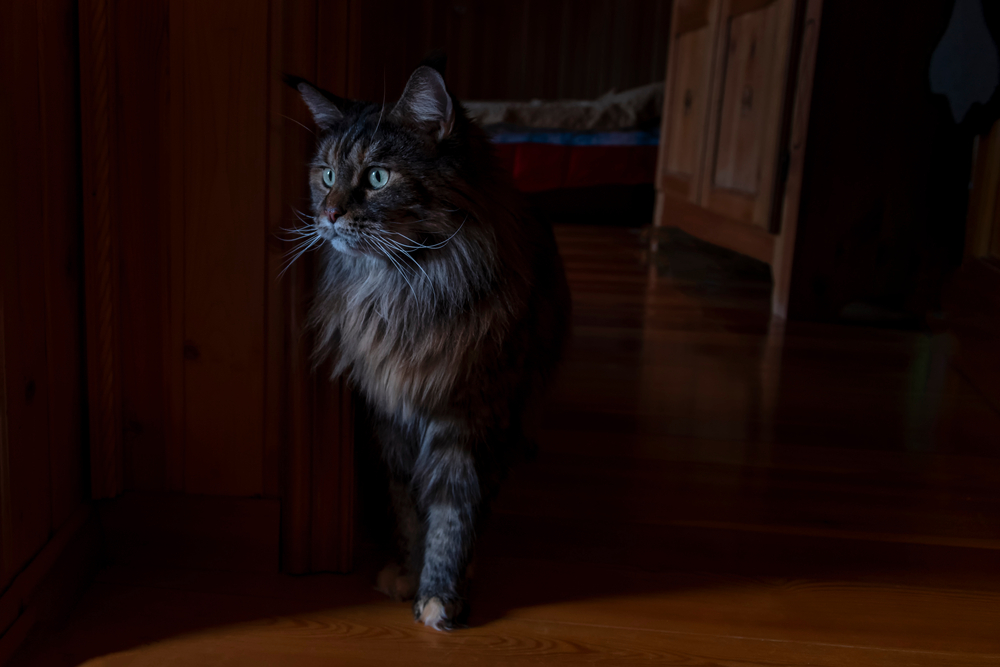Cats are truly fascinating creatures. From their love of boxes to the myriad cat sleeping positions, plus the idea that cats have nine lives along with various other cat facts, there are few animals that are more intriguing – to us cat-lovers, at least! One mystery that has plagued humans for many years is the belief that cats have stellar night vision. But is this fact or fiction? Can cats see in the dark or do we just think they can?
We’re solving the conundrum once and for all so you’re no longer left in the dark – you’re welcome!
Can cats see in the dark?
Because kitties stay active at night, we’d be forgiven for thinking they can see perfectly well in a pitch-black environment. But, we’re a little misguided when it comes to the question “Can cats see in the dark?”
Cats can’t actually see in total darkness any better than humans. It’s only in low light that cats have excellent vision. In other words, they need at least some light to be able to see.
In saying that, cats’ eyes are still significantly better at seeing in low light than ours. They can see in light six times dimmer than the lower limit of humans – which is no mean feat!
And while we’re here, we thought we’d explore the idea of cats being nocturnal – largely driven by the belief that they can see in the dark. In fact, they’re not nocturnal at all.
Cats are crepuscular, which means they’re particularly energetic at dawn and dusk. This is a hangover from their days living and hunting in the wild, as their prey were equally active at these times. As a result, you or your trusted Cat Sitter may notice your cat playing more in the early morning or evening!
How do cats’ eyes work?
If cats can see in low light better than humans, why is that so? Put simply, their eyes are built quite differently from ours.
Cats’ eyes can let in a lot more light thanks to their unique and very clever set-up. Within their eyes (and ours), there are cells known as rods and cones. Rods are ideal in low light, as they’re more sensitive. Cones are great for seeing in the day, as they need a lot of light to work properly. They’re also fantastic at sensing colours.
Cats have significantly more rods than cones, which is why they’re so good at seeing in low light. However, the relative lack of cones means they’re not quite as skilled when it comes to detecting colours. Human eyes are effectively the opposite. We have more cones than rods, which means we can detect colours really well but struggle in low-light environments.
Cats are also blessed with a membrane called the tapetum lucidum, which helps them see better in dim light. This is effectively a kind of “mirror” that sits right at the back of their eyes. Its job is to help reflect even more light into a cat’s eyes. It also happens to be the reason why cats get freaky glow-in-the-dark eyes whenever a light shines on them!
And lastly, cats are better able to dilate their pupils to let in more light. You know what we’re referring to: that time when their pupils are no longer slits, but instead expand almost to the edges of their eyes. Not only is this incredibly adorable, but it’s a very handy tool for seeing in darker environments.
Can certain cat breeds see in the dark better than others?
To answer this question, we need to return to that “mirror” we mentioned earlier. In most cats – that is, those with green, hazel, or brown eyes – the tapetum lucidum emits a silvery-green glow whenever it’s reflecting light. In blue-eyed felines, though, it emits a more reddish glow. This is because their tapetum is slightly abnormal. Experts suspect this abnormality means they can’t see quite as well in the dark.
Cat breeds that can have blue eyes include the Balinese, Himalayan, Birman, Siamese, Ragdoll, Turkish Angora, Turkish Van, and Persian. It’s very possible that these breeds may not be as good at navigating low light as other cats.
Can cats see in the dark better than other animals?
We know now that cats do pretty well in low-light situations, but do they do better than other animals?
Cats aren’t the only animals with that nifty tapetum lucidum, which makes seeing in the dark a heck of a lot easier. Dogs, horses, cows, deer, goats, sheep, birds like owls and kiwis, and even frogs have them, too. It’s believed that animals requiring some element of night vision – usually, if they’re nocturnal or live in low-light conditions – have evolved with a tapetum lucidum.
Of these animals, owls are widely considered to have the best night vision. Frogs are also pretty darn skilled at seeing in the dark, possibly better than cats.
One thing’s for sure, though: cats are definitely better at operating in low light than dogs. (Wondering, “Can dogs see in the dark?” We’ve got all the answers!) Sorry, dog-lovers!

